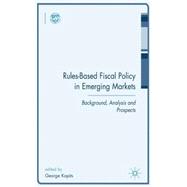
| List of Tables | vii | ||||
| List of Figures and Box | ix | ||||
| List of Contributors | x | ||||
| Acknowledgments | xi | ||||
| Foreword | xii | ||||
| 1 Overview of Fiscal Policy Rules in Emerging Markets | 1 | (12) | |||
|
|||||
| Part I Political Economy and Macroeconomic Setting | 13 | (82) | |||
|
15 | (15) | |||
|
|||||
|
30 | (23) | |||
|
|||||
|
53 | (13) | |||
|
|||||
|
66 | (15) | |||
|
|||||
|
81 | (16) | |||
|
|||||
| Part II Design Issues at the National Level | 95 | (86) | |||
|
97 | (17) | |||
|
|||||
|
114 | (17) | |||
|
|||||
|
131 | (15) | |||
|
|||||
|
146 | (18) | |||
|
|||||
|
164 | (17) | |||
|
|||||
| Part III Design Issues at the Subnational Level | 181 | (69) | |||
|
183 | (15) | |||
|
|||||
|
198 | (21) | |||
|
|||||
|
219 | (16) | |||
|
|||||
|
235 | (15) | |||
|
|||||
| References | 250 | (18) | |||
| Author Index | 268 | (3) | |||
| Subject Index | 271 |
The New copy of this book will include any supplemental materials advertised. Please check the title of the book to determine if it should include any access cards, study guides, lab manuals, CDs, etc.
The Used, Rental and eBook copies of this book are not guaranteed to include any supplemental materials. Typically, only the book itself is included. This is true even if the title states it includes any access cards, study guides, lab manuals, CDs, etc.